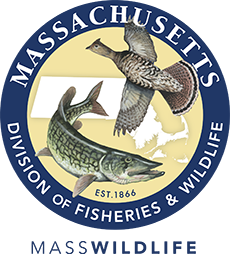- Division of Fisheries and Wildlife
- MassWildlife's Natural Heritage & Endangered Species Program
Media Contact
Media Contact, MassWildlife

About 75 plants, insects, and animals on the Massachusetts Endangered Species List depend on habitats that experience periodic fires. But natural wildland fires that support fire-dependent ecosystems have been suppressed for decades in the interest of public safety. Fortunately, many of these specialized plants and animals are incredibly resilient. Plants can lie dormant as seeds in the ground for decades waiting for the right growing conditions to return. Mobile species, like birds, bees, and moths, can travel to restored areas to recolonize fire-influenced habitats. This plant and animal resilience is on full display at MassWildlife’s Muddy Brook Wildlife Management Area (WMA) in Hardwick.
The greater Muddy Brook Valley contains a collection of globally rare, fire-influenced habitats. After 70 years of fire exclusion, most of these habitats were not able to support the specialized plant and animal species that once occurred there. MassWildlife began habitat restoration work at Muddy Brook WMA in 2014 after years of planning. Restoration included tree canopy thinning and prescribed fire treatments. Within a year of the first prescribed fire, an abundance of native plants—some that been absent for decades—began to emerge from the seedbank and become established. After a few growing seasons, long-absent insects and birds were observed making use of the restored habitat.
The most recent marker of success was discovered in the summer of 2023. MassWildlife biologists observed the orange sallow moth (Pyrrha aurantiago) at Muddy Brook WMA. This is the seventh MESA-listed moth species recorded in the valley since the habitat restoration work began.
The orange sallow moth is listed as a Species of Special Concern in Massachusetts. The moth’s larva (caterpillar) feed exclusively on the flowers, seeds, and leaves of false foxglove plants (Aureolaria spp.). False foxglove grow in areas with occasional fire. Surveys show that false foxglove was not growing in the Muddy Brook Valley in the years leading up to the restoration work. Following initial canopy thinning and the introduction of prescribed fire, a small patch of fern-leaved foxglove emerged from the seedbank in 2019. By 2023, more than 1,000 foxglove plants were counted, and in August the orange sallow moth was discovered at this foxglove patch.
The false foxglove plants at Muddy Brook likely originated from seed that had been dormant since the late 1950s. Habitat restoration allowed sunlight to reach the soil and re-introduced fire where it had been absent for decades. The nearest orange sallow population is about 5 miles away. The moths detected the growing patch of foxgloves (likely signaled by the fragrant flowers) and set out to colonize this new habitat.
The orange sallow at Muddy Brook is just one of many amazing examples of the resilience displayed by fire-adapted plants and animals. Less than a decade after restoration work began, Muddy Brook WMA now supports over 20 MESA-listed species, including whip-poor-wills, rare bees, and Endangered plants. All of these have similar stories to the orange sallow that show how their highly specialized adaptations allow them to reemerge and flourish following long periods of time.
Restoration success stats
Muddy Brook WMA is showing an impressive ecological response to MassWildlife’s habitat restoration work including:
- The emergence of 28 fire-influenced plants not observed prior to restoration, including 4 Endangered, 1 Threatened, 1 Special Concern, and 5 Watchlist species;
- The return of the eastern whip-poor-will bird to the site following a documented 30-year absence;
- A significant increase in early successional breeding birds, including the American woodcock, prairie warbler, field sparrow, and eastern towhee;
- An increase in bee species from 36 to 150 species (including 1 Threatened); and
- A growing list of specialized moths and butterflies that includes several state-listed species.


